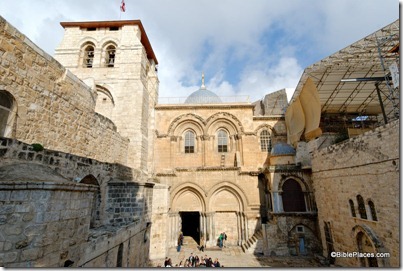An official government organization, the Jerusalem Development Authority, sent out their “Monthly Jerusalem Newsletter” today with these “Facts about Jerusalem.”
- King David made Jerusalem the capital of Israel 3,000 years ago.
- The Western Wall in the Old City is the last remaining wall of the ancient Second Jewish Temple which was destroyed by the Romans in 70CE.
- For Christians, Jerusalem is the place where Jesus lived, preached, died, and was resurrected.
- According to Islam, the prophet Muhammad was miraculously transported from Mecca to Jerusalem, and then ascended to Heaven.
- Mishkenot Sha’ananim is the first area of habitation in Jerusalem outside the Old City walls. It’s building began in 1860.
- Jerusalem today has over 10,000 hotel rooms with another 10,000 planned in the coming years.
- The most visited site in Israel is in Jerusalem. It is the Church of the Holy Sepulcher, the traditional site of Jesus’ crucifixion.
See any problems?
Church of the Holy Sepulcher

15 thoughts on “Facts About Jerusalem”
I guess we can begin with…
– …the Western Wall being the last wall of the ancient Temple instead of a retaining wall in the supporting platform. (The other original Herodian stones must then date to a different period – no doubt Islamic.)
– Jesus lived in Jerusalem? Maybe it was near the family tomb in Talpiot. (Wait, never mind… that would have been outside the city walls.)
– Speaking of walls,this "first" habitation outside the walls should be linked only to the "recent" Jerusalem of the past few centuries. Iron Age Jerusalem, among other periods, should certainly not be included in this tidbit.
– The most visited site in Jerusalem? I thought it would have been [insert clever remark here].
Jesus didn't live in Jerusalem all that much.
I am not as knowledgeable as you, but I want to learn. So please tell us the problems …
"It’s building began…" s/b "Its".
I was trying to have some fun with it earlier. Here's a straightforward breakdown.
a) The Western Wall is not a wall of the 2nd temple. It served as a side/retaining wall for a platform Herod built on the summit of the actual mountain. The temple itself was on the platform but was totally obliterated in antiquity. No wall of it remains today.
b) Jesus preached, died, and was resurrected Jerusalem, but there is no record of Him ever living there. (The "family tomb" comment was a joke about a claim a few years ago that Jesus' family tomb had been found near the city.)
c) The first area of habitation outside the present walls is true as far as I know. In ancient times, Jerusalem frequently outgrew its walls and enclosed new neighborhoods.
d) Grena has a good grammatical eye.
Dale – the answers are in the comments of the others. Luke was right both times.
The its mistake does bug me, but it's worse when a government agency claiming to have expertise on a subject publishes a list of "facts" with a number of very basic historical errors.
I find it hard to believe that the most visited site in all of Israel is the Church of the Holy Sepulcher. I would guess that more people visit the Western Wall, Jaffa Gate, Damascus Gate, and the overlook from the Mount of Olives.
I shudder to think of 10,000 more hotel rooms with all of the existing infrastructure failures.
A practical problem: I think you have mentioned before the traffic problem in Jerusalem. Adding 10,000 hotel rooms will make the situation around the Old City nearly impossible to negotiate.
So to clarify, is the Western Wall then the only retaining wall left from the Herod complex?
Living – that's another mistake. The retaining walls of Herod's temple mount exist on all four sides, though I'm not sure that any of the northern portion of Herodian construction is visible to the public today.
The first problem I saw was the "it's". But Israeli law requires that all public and commercial signs in English must contain at least two mistakes, so this piece is at least partially in compliance.
The second problem I saw is that of the Church of the Holy Sepulcher. Is that truly the traditional site of the crucifixion? Wouldn't that rather have happened at Golgotha hill, and the burial itself being in the Holy Sepulcher?
Michael – the Church of the Holy Sepulcher incorporates the traditional Golgotha. (The New Testament never says that Golgotha was a hill.)
10,000 more rooms full of people visiting the Church of the Holy Sepulcher?
I think others have found most of the errors. Makes you wonder who fact checks what the government publishes.
I realize this question may appear ignorant, but…if the Western Wall is not the last remaining retaining wall from the 2nd temple period, why is it so highly regarded and visited so often?
The Western Wall is deemed to be the closest to the former location of the temple. Besides that, it is believed to have been sanctified by more than a millennia of prayers.